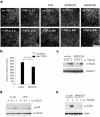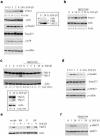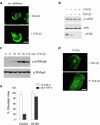A critical role of tropomyosins in TGF-beta regulation of the actin cytoskeleton and cell motility in epithelial cells
- PMID: 15317845
- PMCID: PMC519159
- DOI: 10.1091/mbc.e04-04-0353
A critical role of tropomyosins in TGF-beta regulation of the actin cytoskeleton and cell motility in epithelial cells
Abstract
We have investigated transforming growth factor beta (TGF-beta)-mediated induction of actin stress fibers in normal and metastatic epithelial cells. We found that stress fiber formation requires de novo protein synthesis, p38Mapk and Smad signaling. We show that TGF-beta via Smad and p38Mapk up-regulates expression of actin-binding proteins including high-molecular-weight tropomyosins, alpha-actinin and calponin h2. We demonstrate that, among these proteins, tropomyosins are both necessary and sufficient for TGF-beta induction of stress fibers. Silencing of tropomyosins with short interfering RNAs (siRNAs) blocks stress fiber assembly, whereas ectopic expression of tropomyosins results in stress fibers. Ectopic-expression and siRNA experiments show that Smads mediate induction of tropomyosins and stress fibers. Interestingly, TGF-beta induction of stress fibers was not accompanied by changes in the levels of cofilin phosphorylation. TGF-beta induction of tropomyosins and stress fibers are significantly inhibited by Ras-ERK signaling in metastatic breast cancer cells. Inhibition of the Ras-ERK pathway restores TGF-beta induction of tropomyosins and stress fibers and thereby reduces cell motility. These results suggest that induction of tropomyosins and stress fibers play an essential role in TGF-beta control of cell motility, and the loss of this TGF-beta response is a critical step in the acquisition of metastatic phenotype by tumor cells.
Figures









Similar articles
-
Role of high-molecular weight tropomyosins in TGF-beta-mediated control of cell motility.Int J Cancer. 2008 Jan 1;122(1):78-90. doi: 10.1002/ijc.23025. Int J Cancer. 2008. PMID: 17721995
-
Transforming growth factor-beta-induced mobilization of actin cytoskeleton requires signaling by small GTPases Cdc42 and RhoA.Mol Biol Cell. 2002 Mar;13(3):902-14. doi: 10.1091/mbc.01-08-0398. Mol Biol Cell. 2002. PMID: 11907271 Free PMC article.
-
Ras alters epithelial-mesenchymal transition in response to TGFbeta by reducing actin fibers and cell-matrix adhesion.Cell Cycle. 2009 Jan 15;8(2):284-98. doi: 10.4161/cc.8.2.7590. Cell Cycle. 2009. PMID: 19177011
-
TGF-beta signal transduction in corneal wound healing as a therapeutic target.Cornea. 2004 Nov;23(8 Suppl):S25-30. doi: 10.1097/01.ico.0000136668.41000.73. Cornea. 2004. PMID: 15448476 Review.
-
TGF-beta and epithelial-to-mesenchymal transitions.Oncogene. 2005 Aug 29;24(37):5764-74. doi: 10.1038/sj.onc.1208927. Oncogene. 2005. PMID: 16123809 Review.
Cited by
-
Smad3 deficiency reduces neurogenesis in adult mice.J Mol Neurosci. 2010 Jul;41(3):383-96. doi: 10.1007/s12031-010-9329-x. Epub 2010 Feb 13. J Mol Neurosci. 2010. PMID: 20155334
-
Dynamic and differential regulation in the microRNA expression in the developing and mature cataractous rat lens.J Cell Mol Med. 2013 Sep;17(9):1146-59. doi: 10.1111/jcmm.12094. Epub 2013 Jul 11. J Cell Mol Med. 2013. PMID: 23844765 Free PMC article.
-
Proteomic analysis of mesenchymal stem cells from normal and deep carious dental pulp.PLoS One. 2014 May 8;9(5):e97026. doi: 10.1371/journal.pone.0097026. eCollection 2014. PLoS One. 2014. PMID: 24809979 Free PMC article.
-
DEPTOR promotes survival of cervical squamous cell carcinoma cells and its silencing induces apoptosis through downregulating PI3K/AKT and by up-regulating p38 MAP kinase.Oncotarget. 2016 Apr 26;7(17):24154-71. doi: 10.18632/oncotarget.8131. Oncotarget. 2016. PMID: 26992219 Free PMC article.
-
Elevated tropomyosin expression is associated with epithelial-mesenchymal transition of lens epithelial cells.J Cell Mol Med. 2013 Jan;17(1):212-21. doi: 10.1111/j.1582-4934.2012.01654.x. Epub 2012 Dec 4. J Cell Mol Med. 2013. PMID: 23205574 Free PMC article.
References
-
- Ayscough, K.R. (1998). In vivo functions of actin-binding proteins. Curr. Opin. Cell Biol. 10, 102-111. - PubMed
-
- Bakin, A.V., and Curran, T. (1999). Role of DNA 5-methylcytosine transferase in cell transformation by fos. Science 283, 387-390. - PubMed
-
- Bakin, A.V., Rinehart, C., Tomlinson, A.K., and Arteaga, C.L. (2002). p38 mitogen-activated protein kinase is required for TGF{beta}-mediated fibroblastic transdifferentiation and cell migration. J. Cell Sci. 115, 3193-3206. - PubMed
-
- Bakin, A.V., Tomlinson, A.K., Bhowmick, N.A., Moses, H.L., and Arteaga, C.L. (2000). Phosphatidylinositol 3-kinase function is required for TGFbeta-mediated epithelial to mesenchymal transition and cell migration. J. Biol. Chem. 275, 36803-36810. - PubMed
-
- Bamburg, J.R. (1999). Proteins of the ADF/cofilin family: essential regulators of actin dynamics. Annu. Rev. Cell Dev. Biol. 15, 185-230. - PubMed
Publication types
MeSH terms
Substances
Grants and funding
LinkOut - more resources
Full Text Sources
Molecular Biology Databases
Miscellaneous

